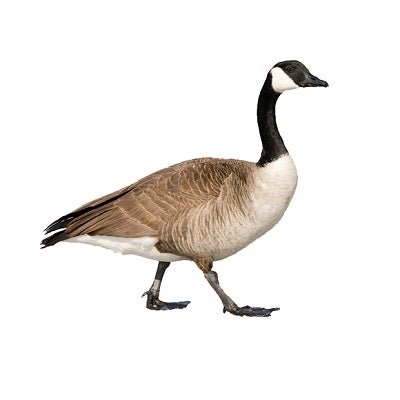
Color: Geese have a black head with white cheeks and chinstrap, black neck, tan breast, and brown back.
Size: Larger than a Mallard, smaller than a Mute Swan.
Both Sexes:
Length: 29.9-43.3 in (76-110 cm)
Weight: 105.8-317.5 oz. (3000-9000 g)
Wingspan: 50.0-66.9 in (127-170 cm)
Just about anywhere near lakes, rivers, ponds, or other small or large bodies of water, and in yards, park lawns, and farm fields.
Feed by dabbling in the water or grazing in fields and large lawns. They are often seen in flight moving in pairs or flocks; flocks often assume a V formation.
Eat small insects and fish. Their diet includes green vegetation and grains, variety of grasses when on land, beans and grains such as wheat, rice, and corn when they are available.
In the water, it feeds from aquatic plants by sliding its bill at the bottom of the body of water. It also feeds on aquatic plants, such as seaweeds.
In urban areas, it is also known to pick food out of garbage bins. They are also sometimes hand-fed a variety of grains and other foods by humans in parks.
The droppings of Canada geese have been found to carry a significant number of diseases, however, only a few are of significant concern to humans.
Canada geese are loud, aggressive and annoying, but worst of all they poop everywhere — a messy problem vexing cities across the country trying to keep their parks clean and safe.
“Geese and their waste ruin youth sports and picnics, make it unpleasant for the elderly who like to walk in the parks, and the waste gets all over dogs’ paws,”
Mowing and maintaining lawns down to the water’s edge, or maintaining very large lawns anywhere near water are open invitations to Canada Geese.
Plastic mesh placed over grass usually discourages them from walking on a lawn.
Manufacturer Recommended Products And Treatment For Goose Control
Pests need food, water, and shelter. Often the problem may be solved just by removing these key items. Before even thinking about chemical pest control, it is important to be aware of
| Conducive Condition | Recommendation | |
| 1 | Tree branches on house | Keep tree branches away from house to reduce pest access |
| 2 | Firewood next to foundation | Keep firewood away from house to reduce pest harborage |
| 3 | Debris on crawlspace/next to foundation | Remove wood debris to reduce termite ha rborage area |
| 4 | Excessive plant cover, stump, etc. | Providing spacing between plant cover and structure |
| 5 | Soil above the foundation Ii ne | Keep soil below top of foundation to reduce harbo rage areas |
| 6 | Wood-to-ground contact | Keep soil from touching wood to eliminate termite access |
| 7 | Debris on roof/full gutter | Keep gutter & roof free of debris to reduce insect harborage |
| 8 | Standi ng water near/under structure | Eli minate standing water to reduce pest harbo rage |
| 9 | Mo isture problem under structure | Increase ventilation to reduce pest harbo rage area |
| 10 | Openi ngs at plumbi ng & electronics | Seal opening to reduce pest access |
| 11 | Excessive gaps at windows/doors | Seal gaps to reduce pest access |
| 12 | Lea ky plumb ing fixtures | Repair to reduce moisture for pests |
| 13 | Keep garbage cans covered | Covered to reduce attraction of insects of vertebrate pests |
| 14 | Mo isture damage wood | Repair rotten or damaged wood to reduce insect harborage |
| 15 | Grocery bags stored improperly | Seal paper sacks in containers to reduce i nsect ha rborage areas |
| 16 | Pet food unsealed or left out | Keep pet food in sealed containers and unavailable to pests |
| 17 | Excessive storage conditions | Keep storage areas uncluttered and manageable |
| 18 | Debris below kick plates | Remove kick plates to reduce rodent harborage |
1 product


